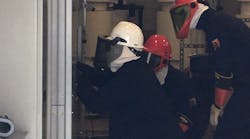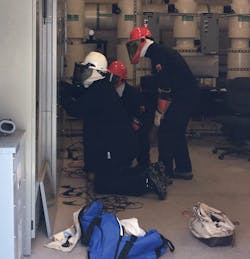The addition of the term risk assessment was a change made in the 2015 revision of NFPA 70E, and additional emphasis was added to the risk assessment requirements in the 2018 revision. Prior to 2015, NFPA 70E revisions referenced a hazard assessment, which seemed to imply that severity was the only critical element of the evaluation.
The change from hazard to risk brings in the idea of evaluating both probability and severity of electrical hazards as well as keeping the NFPA 70E consistent with recent changes found in similar standards that address risks and hazards. An arc flash hazard should be evaluated according to: 1) how likely it is that an arc flash incident is to occur; and 2) if one does occur, how severe could it be. The result of this arc flash risk assessment will help guide electrical professionals in determining the appropriate hazard mitigation methods to use.
When is an arc flash risk assessment required?
The 2018 edition of NFPA 70E requires an arc flash risk assessment be performed during the job safety planning process before starting any work that involves exposure to electrical hazards. Energized Electrical Work Permits are required to include the results of the arc flash risk assessment associated with the task to be performed. The bottom line is any task that involves potential for a worker to be exposed to electrical hazards must have an arc flash risk assessment performed.
Not all tasks that involve potential electrical hazard exposure will include a potential for an arc flash hazard, but this should be determined through the arc flash risk assessment. Even in the case where an arc flash risk assessment results in no likelihood of an arc flash event, the process is still required, and the results must be documented. The general purpose is to identify arc flash hazards, estimate the likelihood of occurrence and the potential severity of injury or damage to health, and determine if additional protective measures are required to mitigate the hazard.
What does an arc flash risk assessment involve?
Likelihood and probability — 130.5 of NFPA 70E puts forth the requirements for conducting an arc flash risk assessment. The first step is to estimate the likelihood of occurrence and the potential severity of injury or damage to health. This estimation should consider the design of the electrical equipment and associated overcurrent protective devices, including its operating time, and should include the status of maintenance and operational capability. One example to consider is a panel that looks brand new and in excellent condition would likely have less probability of posing an arc flash hazard than a panel that is old, corroded, and is missing blank covers that leave the bus exposed. Likewise, an older motor control center that has never had any preventive maintenance performed on it may have a greater risk than one that is part of a mature effective electrical equipment maintenance program.
Hierarchy of risk control methods — If the likelihood and severity indicate that there is risk of an arc flash incident, the next step is to determine additional protective measures needed to mitigate the arc flash risk. Additional protective measures should be selected and implemented according to the hierarchy of risk control. The hierarchy of risk control methods were only included as an Informational Note in the 2015 edition of NFPA 70E but are now part of the specific requirements in the 2018 edition [110.1(H)]. This hierarchy is being adopted by similar standards and is explained in more detail in ANSI/AIHA Z10, American National Standard for Occupational Health and Safety Management System. The expectation is that workers should follow a specific priority of options when determining the best way to mitigate the hazard. The prioritized order is as follows:
(1) Elimination
(2) Substitution
(3) Engineering controls
(4) Awareness
(5) Administrative controls
(6) Personal protective equipment (PPE)
The overall idea is to start with mitigations that avoid exposure to the hazard. If these are not feasible, continue down the priority list with the final option of using PPE to protect workers during their time of exposure to an arc flash hazard.
Arc flash boundary — After determining appropriate risk control methods, any applicable safety-related work practices must be identified and associated with each method, including the arc flash boundary and the PPE that is required for anyone that is inside the boundary. The arc flash boundary is the distance at which the incident energy equals 1.2 cal/cm2. The preferred method for determining the arc flash boundary is through calculations associated with an incident energy analysis. In lieu of the analysis, it is permitted to be determined by Table 130.7(C)(15)(a) or Table 130.7(C)(15)(b) when the requirements of these tables apply.
Arc flash PPE — Knowing that there is a potential for an arc flash event to occur, the next requirement is to determine what arc flash PPE is required within the arc flash boundary. The required minimum rating of arc flash PPE can be determined either by the incident energy analysis method in accordance with 130.5(G) or the arc flash PPE category method in accordance with 130.7(C)(15). From the perspective of clearly understanding the severity of the hazard, the incident energy analysis method is always the preferred method. However, the incident energy analysis method requires data collection, system modeling, and calculations, all of which take time. In lieu of this method being finalized, NFPA 70E allows the use of Table 130.7(C)(15)(a) or Table 130.7(C)(15)(b) to determine required PPE when the requirements of these tables apply.
Documentation — Arc flash risk assessment results are required to be documented. Documentation can take many forms depending on the level of risk and the complexity of the mitigating actions. Low risk tasks may simply be documented as part of the job planning document while higher risk tasks may have a separate arc flash risk assessment document. If the arc flash risk analysis involves performing an incident energy analysis, documentation may include labeling equipment with incident energy analysis results. As stated in 130.6(H), electrical equipment that is likely to require examination, adjustment, servicing, or maintenance while energized is required to be marked with a label containing the nominal system voltage, arc flash boundary distance, and an indication of the minimum PPE required within the arc flash boundary.
Key takeaways
Any task that has the potential to involve an electrical hazard must include an arc flash risk assessment from inception. The overall goal of the assessment is to encourage a deliberate thought process that allows qualified electrical workers opportunity to determine feasible means to avoid exposure to an arc flash hazard. If the assessment determines that the potential arc flash hazard exposure cannot be avoided, the assessment process facilitates a logical method for determining preferred means to protect the workers from arc flash hazards. While this process may seem tedious at times, the habits that are developed through following this process consistently may indeed prevent unimaginable pain and suffering caused by experiencing an arc flash event with insufficient protection.
Northcott, a professional engineer licensed in the state of Tennessee and a certified maintenance and reliability professional, is a senior power engineer with Jacobs Technology, Inc., in Tullahoma, Tenn. He can be reached at [email protected].





